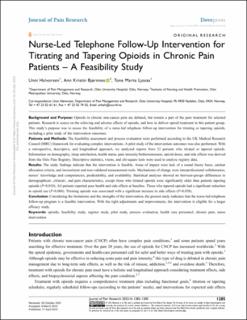| dc.description.abstract | Background and Purpose: Opioids in chronic non-cancer pain are debated, but remain a part of the pain treatment for selected patients. Research is scarce on the relieving and adverse effects of opioids, and how to deliver opioid treatment in this patient group. This study’s purpose was to assess the feasibility of a nurse-led telephone follow-up intervention for titrating or tapering opioids, including a pilot study of the intervention outcomes.
Patients and Methods: The feasibility assessment and process evaluation were performed according to the UK Medical Research Council (MRC) framework for evaluating complex interventions. A pilot study of the intervention outcomes was also performed. With a retrospective, descriptive, and longitudinal approach, we analyzed reports from 32 patients who titrated or tapered opioids. Information on demography, sleep satisfaction, health status, pain intensity/bothersomeness, opioid doses, and side effects was derived from the Oslo Pain Registry. Descriptive statistics, t-tests, and chi-square tests were used to analyze registry data.
Results: The study findings indicate that the intervention is feasible. Areas of impact were lack of a sound theory basis, unclear allocation criteria, and inconsistent and non-validated measurement tools. Mechanisms of change were interprofessional collaboration, nurses’ knowledge and competencies, predictability, and availability. Statistical analyses showed no between-groups differences in demographical-, clinical-, and pain characteristics, except those who titrated opioids were significantly older than patients tapering opioids (P=0.010). All patients reported poor health and side effects at baseline. Those who tapered opioids had a significant reduction in opioid use (P=0.004). Titrating opioids was associated with a significant increase in side effects (P=0.038).
Conclusion: Considering the limitations and the strengths of the intervention, the present study indicates that the nurse-led telephone follow-up program is a feasible intervention. With the right adjustments and improvements, the intervention is eligible for a larger efficacy study. | en_US |

